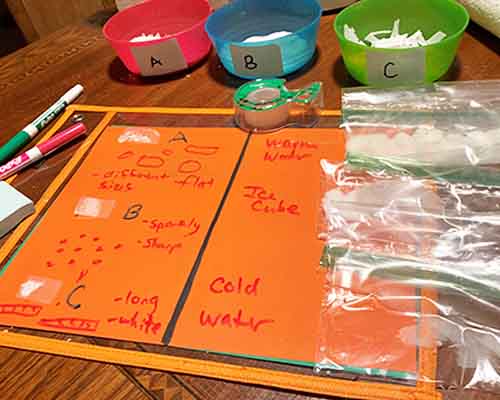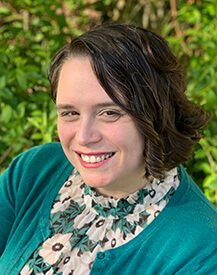Exploring Snow

Snow Activities for Preschoolers
Bring the "snow" indoors. Here are snow activities for
preschoolers to do inside during those cold winter months!
By Hollie Barattolo
Snow Activities for Preschoolers
Bring the "snow" indoors. Here are snow activities forpreschoolers to do inside during those cold winter months!
By Hollie Barattolo
Ages/Grades
Preschool, Early Elementary
Learning Domains
Science, Fine Motor
Materials
- • 6-10 empty containers for the mystery snow
- • Baggies, small cups, or bowls for each student
- • Magnifying glasses
- • Transparent tape
- • Flashlights
- • Scoop (tablespoon, coffee ground scoop)
- • Water
- • Ice
- • Medicine droppers
Gather 6-10 of the following “snow” substances:
- • Insta-Snow
- • Sugar (granulated/powdered)
- • Salt
- • Powdered potatoes
- • White pom-poms
- • Glitter
- • Cornstarch
- • Powdered milk
- • Shredded paper
- • Cotton balls
- • Marshmallows
- • Sand
- • Crushed Ice
- • White Beads
- • Rice (cooked/uncooked)
Ready, Set, Go!
 Choose 6-10 of the “snow” substances and place each in a jar or can labeled with just a letter, color, or number. This will keep them a surprise for the students.
Choose 6-10 of the “snow” substances and place each in a jar or can labeled with just a letter, color, or number. This will keep them a surprise for the students. Lead a discussion of snow. Students can share personal experiences or impressions they have gotten from movies or books. Gather a list of words to describe snow and how snow makes them feel.
Lead a discussion of snow. Students can share personal experiences or impressions they have gotten from movies or books. Gather a list of words to describe snow and how snow makes them feel.- Exploration Questions: What are some words you could use to describe snow? What color is snow? Is it sparkly? Do you usually see one snowflake or many snowflakes?
 Tell your students that they will be snow scientists today! They are going to learn as much as they can about the mystery “snow”. Tell the students that what they will be using isn’t real snow, but has some things in common with snow. Use your generated list of words to describe snow to make the connections.
Tell your students that they will be snow scientists today! They are going to learn as much as they can about the mystery “snow”. Tell the students that what they will be using isn’t real snow, but has some things in common with snow. Use your generated list of words to describe snow to make the connections. Allow the students to choose 1-3 of the mystery snows. Give each student a scoop of their chosen snow to observe. Make as many observations using as many senses as possible.
Allow the students to choose 1-3 of the mystery snows. Give each student a scoop of their chosen snow to observe. Make as many observations using as many senses as possible.- Exploration Questions: Which snow has the largest pieces? Which snow has the most pieces? Does the snow have pointy pieces or round pieces? Are all the snows the same color? Do any stick to your fingers when you touch them? Are any sparkly? What does your snow smell like? If we shake your snow in a closed container, does it make any noise?
- Tips:
Depending on your level of comfort with mess, students can either make observations of the snow while it is in a baggie or you can let them touch the snow to make observations.
Don’t forget to break out those magnifying glasses to take a closer look.
Shine a flashlight on them to pick up on any sparkles!
Use a piece of transparent tape to pick up single “snowflakes” for closer inspection.  Explain that scientists do experiments to learn more about the world around them, and that your students will be testing what water does to their mystery snow. The value of this experiment is allowing students to choose their own methods of adding water to the snow.
Explain that scientists do experiments to learn more about the world around them, and that your students will be testing what water does to their mystery snow. The value of this experiment is allowing students to choose their own methods of adding water to the snow.- Some choices they can make:
Which 1-3 snows they want to learn more about
Add cold water or room temp water to the snow
Add the water to the snow or the snow to the water
add ice cubes or crushed ice
Drip water on with an eye dropper or pour water on with a small cup
Stir or not stir the water into their snow.  While the students are conducting their experiments, ask them to draw pictures of what happens to the snow when water is added so they can share what they learned with their classmates.
While the students are conducting their experiments, ask them to draw pictures of what happens to the snow when water is added so they can share what they learned with their classmates. Group students to share what they learned about their mystery snow. They should also share how they added water.
Group students to share what they learned about their mystery snow. They should also share how they added water.- Exploration Questions: Did anyone work on the same mystery snow and get different results? What happened to the powdered snow? Did the water get sucked in or sit on top? Did anyone have a snow that took up more space when you added water? Did anyone have snow that disappeared when you added water? Did anyone have snow that changed color when water was added?
 What's happening?
What's happening?- This experiment is all about practicing the scientific process--not really learning about snow! Inquiry learning--where the student has some control over the questions they ask and steps they take to solve a problem--is a natural fit for young children. They’re playing around with their world all day, so the way we teach science needs to be playful too! When it comes to science experiments like this one, inquiry learning can feel chaotic and messy, but trust the process and you will be helping young scientists.
 Hollie is certified K-8 teacher who has been educating in the informal education field since 2005. She has developed and implemented countless exciting STEAM programs for families, classrooms, and teachers focused on the natural world, the scientific process, and ancient life. Her professional passions are inquiry, whole family learning, experiential learning starting in early childhood, and the intersection of literacy and science instruction.
Hollie is certified K-8 teacher who has been educating in the informal education field since 2005. She has developed and implemented countless exciting STEAM programs for families, classrooms, and teachers focused on the natural world, the scientific process, and ancient life. Her professional passions are inquiry, whole family learning, experiential learning starting in early childhood, and the intersection of literacy and science instruction.
She has recently developed a community-based program that encourages families to use dramatic play to learn science, increase literacy skills, and have fun together for which she received the Drexel University Presidential Award for Civic Engagement. She is most proud of her work on a popular science storytelling program for preschool families and classrooms that combines a book club format with engaging programs, innovative curriculum, and a hysterical puppet storyteller.
